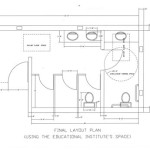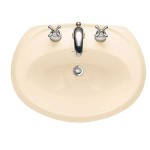How Much Water Does a Bathroom Sink Hold?
Understanding the water capacity of a bathroom sink is essential for various reasons. From calculating water usage to preventing overflows and ensuring proper drainage, knowing the approximate volume your sink can hold proves valuable. This article explores the factors influencing a bathroom sink's water capacity, providing general estimates and methods for calculating the volume of your specific sink.
The capacity of a bathroom sink is not a fixed value. It varies considerably depending on several factors related to the sink's design and dimensions. These factors include the shape of the basin, the depth, the width, and the overall style of the sink. Consequently, providing a single, definitive answer to the question of how much water a bathroom sink holds is not feasible. Instead, an understanding of the parameters influencing this volume is necessary.
Generally, bathroom sinks are designed to hold a reasonable amount of water for tasks such as washing hands, brushing teeth, or a quick face wash. They are not intended to hold significantly large volumes, as this would be inefficient and potentially lead to water wastage. Standard bathroom sinks typically hold between one and three gallons of water. However, this is a broad range, and the actual capacity of a specific sink can fall outside of these boundaries depending on its design.
Deeper sinks, naturally, will hold more water than shallower sinks. A vessel sink, for instance, characterized by its bowl-like design sitting atop the counter, usually holds a greater quantity of water than a standard drop-in sink that is partially recessed into the countertop.
The shape of the sink also plays a significant role. A rectangular sink with straight sides will hold a different volume than a rounded or oval sink with curved contours. The presence of sloping sides, common in some sink designs, also affects the overall capacity, as the volume increases non-linearly with the water level.
Material composition has minimal impact on a sink’s water holding capacity. Whether the sink is constructed from porcelain, ceramic, stainless steel, or stone, the material itself does not affect the interior dimensions or the volume it can contain. The material does influence the sink’s weight and durability, but not its water capacity.
Certain features of the sink’s design can also impact how effectively the water is held. An improperly functioning drain, for example, will lower the usable water capacity. The presence of an overflow drain, a common feature in many sinks, is designed to prevent overfilling. This overflow drain effectively limits the maximum usable capacity of the sink, as any water above its level will be diverted down the drain.
Understanding Sink Types and Their Approximate Capacity
Different types of bathroom sinks exist, each characterized by unique design features and, consequently, varying water capacities. A review of common sink types provides a better understanding of the range of potential water volumes.
Pedestal Sinks: These sinks consist of a basin supported by a freestanding pedestal. While the basin shape can vary, they tend to be on the smaller side, generally holding between one and two gallons of water. Pedestal sinks are often selected for their aesthetic appeal and space-saving design. However, their smaller size often means a lower water capacity.
Drop-In Sinks (Self-Rimming Sinks): These sinks are installed by dropping them into a pre-cut hole in the countertop. They are typically characterized by a raised rim that rests on the countertop, providing a seal. The basins of drop-in sinks vary significantly in size and shape, but they commonly hold between 1.5 and 2.5 gallons of water. The wide range reflects the diverse designs available in this category.
Undermount Sinks: Undermount sinks are installed beneath the countertop, creating a seamless transition from the counter surface to the sink basin. This type of sink often offers a larger basin area than drop-in sinks. Their capacity typically ranges from 2 to 3 gallons. The lack of a raised rim allows for more usable space within the basin.
Vessel Sinks: Vessel sinks sit directly on top of the countertop, resembling a bowl or basin. They are typically larger and deeper than other sink types, often holding between 2 and 4 gallons of water. The increased height and depth contribute to a greater water capacity.
Wall-Mounted Sinks: These sinks are attached directly to the wall, without a countertop or pedestal for support. They are often chosen for their space-saving design. Wall-mounted sinks typically hold between 1 and 2 gallons of water. Similar to pedestal sinks, their compact size often limits their water capacity.
These ranges are approximate, and the actual capacity of a specific sink may vary. Examining the dimensions and shape of the sink directly is the most accurate method for determining its water-holding capability.
Methods for Calculating the Water Capacity of a Bathroom Sink
While estimated ranges are useful, accurately determining the water capacity of a specific bathroom sink requires direct measurement or calculation. Several methods can be employed for this purpose, ranging from simple estimation techniques to more precise volumetric measurements.
The Filling Method: This involves directly measuring the amount of water required to fill the sink to the desired level. This level should be below the overflow drain, if one exists. Use a measuring cup or pitcher with known volume markings. Fill the sink incrementally, carefully counting the number of units of water added. Ensure the sink is level before starting the measurement to obtain accurate results. The sum of the volumes of water added provides an accurate measurement of the sink's capacity.
For this method, choose a measuring container that is appropriately sized for the task. Using a small measuring cup to fill a large sink will take a significant amount of time. Choose a larger container for a faster and more convenient measurement process.
The Displacement Method: This method involves submerging an object of known volume into the sink and measuring the amount of water displaced. While less practical for a bathroom sink, it provides an alternative approach. Fill the sink to a known level. Carefully submerge an object with a known volume (e.g., a measuring cup filled with water) into the sink. Measure the amount of water that overflows from the sink. This amount represents the volume of the object submerged. This method is best suited for sinks without an overflow drain, as the overflowing water is critical for accurate measurement.
The Geometric Calculation Method: This method involves approximating the sink's shape as a geometric solid and calculating its volume using standard formulas. This approach requires precise measurements of the sink's dimensions. The accuracy of this method depends on how closely the sink's shape resembles a standard geometric form. For a rectangular sink, the volume is calculated as length × width × depth. For a cylindrical sink, the volume is calculated as π × (radius)^2 × depth. Complicated sink shapes can be divided into simpler geometric sections, and the volumes of each section can be calculated separately and then summed.
For irregular shapes, this method becomes more complex and less accurate. Consider the curved surfaces of the sink and how closely they resemble known geometric forms. Approximations are often necessary, impacting the overall accuracy of the calculation.
Using Online Calculators: Several online calculators are available that estimate the volume of various shapes. These calculators typically require inputting dimensions such as length, width, depth, and radius. While these online tools can provide a quick estimate, their accuracy depends on the preciseness of the measurements entered and the calculator's underlying algorithms. It is important to ensure that the calculator you choose is appropriate for the shape of your sink.
Regardless of the method chosen, accurate measurements are essential for obtaining reliable results. Use a measuring tape or ruler with clear markings. Double-check your measurements to minimize errors. Be mindful of the units of measurement (e.g., inches, centimeters) and ensure consistency throughout the calculation process. Conversion between units may be required depending on the tools and formulas used.
Factors Affecting Usable Water Capacity
While the methods described above provide an estimate of the sink’s total volume, the usable water capacity – the amount of water practically available for use – can be affected by several factors.
Position of the Overflow Drain: Most bathroom sinks feature an overflow drain, a small opening typically located near the top of the basin. This drain prevents the sink from overflowing by allowing excess water to escape. The position of the overflow drain effectively limits the maximum usable water capacity, as any water above this level will drain away. Therefore, the usable water capacity is less than the total volumetric capacity.
Drain Stopper Functionality: A properly functioning drain stopper is crucial for retaining water in the sink. A leaky or faulty stopper will allow water to gradually drain away, reducing the usable water capacity. Regularly check the stopper for proper sealing and replace it if necessary. Debris or mineral buildup around the stopper can prevent it from sealing tightly. Cleaning the stopper and the surrounding area can improve its functionality.
Faucet Design and Placement: The design and placement of the faucet can indirectly affect the usable water capacity. A faucet that is positioned too high above the sink or at an angle that causes splashing can make it difficult to fill the sink to its maximum usable level without excessive water splashing. The flow rate of the faucet also affects how quickly the sink can be filled. A faucet with a low flow rate may require a longer filling time, while a faucet with a high flow rate may make it easier to overfill the sink.
User Behavior: The way in which the sink is used can also affect the apparent usable water capacity. For instance, if the user frequently fills the sink only partially, the actual usable capacity is limited by their own behavior. Similarly, if the user tends to leave the faucet running continuously while using the sink, the apparent usable water capacity is irrelevant.
Sink Inclination: If the sink is not perfectly level, the water will tend to accumulate on one side. The effective usable capacity would be less than the theoretical capacity. Ensure a level installation for optimal performance.
Considering these factors provides a more realistic understanding of the water capacity actually available for use in a bathroom sink. While the total volume provides a theoretical maximum, practical considerations often limit the amount of water that can be effectively utilized.

Kohler Devonshire Vitreous China Undermount Bathroom Sink In Biscuit With Overflow Drain K 2336 96 The Home Depot

That S As Much Water The Sink Will Hold Picture Of Ibis Nottingham Centre Tripadvisor
How To Measure A Vanity Sink Bathroom Dimensions Standard Size Vevano

Bathroom Sink Guide Lowe S

Little Hole In Sink Explained Family Handyman

Bathtub Capacity How Much Water Does A Bath Hold Barn

Why Is My Bathroom Basin Not Draining Living By Homeserve

How To Clean A Bathroom Sink Overflow Hole

How To Fit A Bathroom Sink Diy Guides Victorian Plumbing

Homeowner S Guide To Bathroom Sink Dimensions And Sizes The Family Handyman
Related Posts







